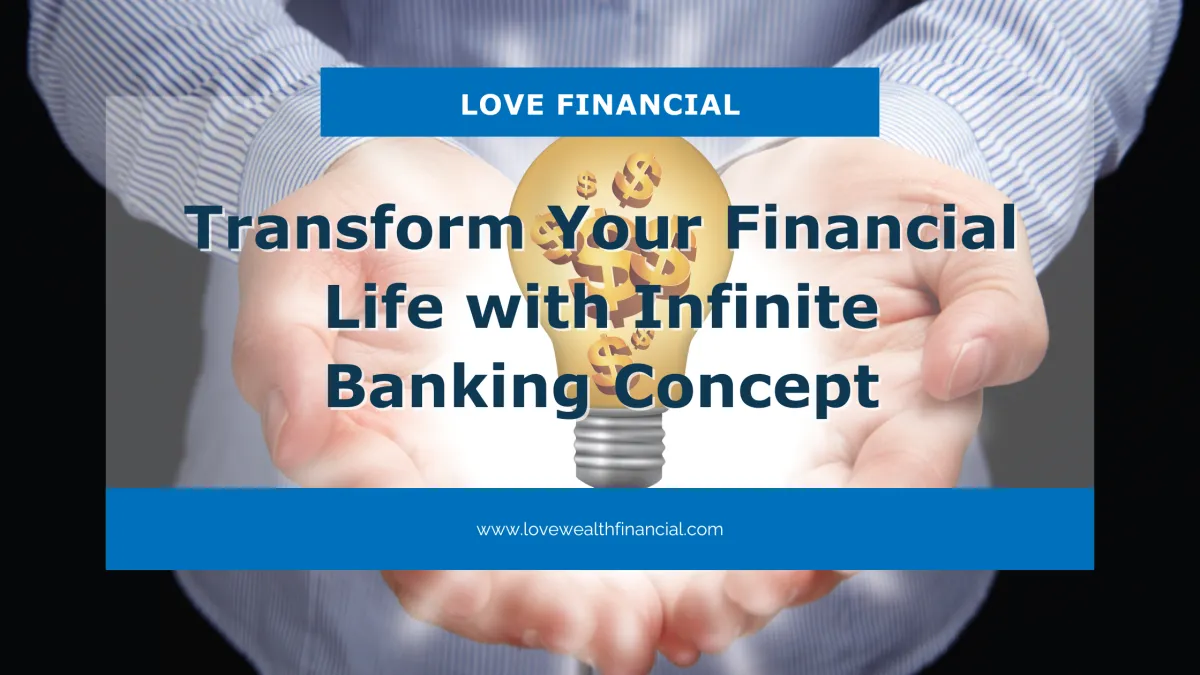

Transform Your Financial Life with the Infinite Banking Concept
June 8, 2024 | #RETIREMENTPLANNING
Transforming your financial life is a crucial step towards achieving long-term financial stability and security.
It involves a comprehensive assessment of your current financial situation, setting clear goals, and implementing strategies to achieve those goals.
In this article, we will explore the Infinite Banking Concept, a powerful tool that can help you take control of your finances and build a more secure financial future.
Why Transforming Your Financial Life Matters
Transforming your financial life is essential because it allows you to break free from the cycle of debt and financial stress.
By understanding your financial situation, setting clear goals, and implementing effective strategies, you can create a financial plan that aligns with your values and goals.
This not only improves your financial well-being but also enhances your overall quality of life.
Understanding Your Current Financial Situation
To transform your financial life, you must first understand your current financial situation. This involves assessing your income and expenses, identifying financial strengths and weaknesses, and setting clear financial goals.
Here are some key steps to follow:
Assess Your Income and Expenses: Start by tracking your income and expenses to understand where your money is going. This will help you identify areas where you can cut back and allocate your resources more effectively.
Identifying Financial Strengths and Weaknesses: Next, identify your financial strengths and weaknesses. Are you good at saving or do you struggle with debt? Understanding your financial strengths and weaknesses will help you develop a more effective financial strategy.
Setting Clear Financial Goals: Setting clear financial goals is crucial to transforming your financial life. These goals should be specific, measurable, achievable, relevant, and time-bound (SMART). Examples of SMART financial goals include saving for a down payment on a house, paying off debt, or building an emergency fund.
Short-Term vs. Long-Term Goals
When setting financial goals, it is essential to differentiate between short-term and long-term goals.
Short-term goals are typically focused on immediate needs, such as paying off debt or building an emergency fund. Long-term goals, on the other hand, are focused on achieving long-term financial security, such as saving for retirement or building wealth.
SMART Financial Goal Setting
SMART financial goal setting involves setting specific, measurable, achievable, relevant, and time-bound goals.
Here are some tips for setting SMART financial goals:
Specific: Make sure your goals are specific and well-defined. For example, instead of setting a goal to "save more," set a goal to "save $1,000 per month."
Measurable: Make sure your goals are measurable, so you can track your progress. For example, instead of setting a goal to "pay off debt," set a goal to "pay off $5,000 in debt within the next six months."
Achievable: Make sure your goals are achievable based on your current financial situation. For example, if you are struggling to make ends meet, it may not be realistic to set a goal to save 20% of your income.
Relevant: Make sure your goals are relevant to your financial situation and values. For example, if you are nearing retirement, it may be more important to focus on saving for retirement rather than building an emergency fund.
Time-bound: Make sure your goals have a specific deadline. This will help you stay focused and motivated.
Creating a Budget That Works
Creating a budget that works involves understanding your financial situation, setting clear goals, and allocating your resources effectively.
Here are some key steps to follow:
The Basics of Budgeting: Start by understanding the basics of budgeting, including the 50/30/20 rule, which allocates 50% of your income towards necessities, 30% towards discretionary spending, and 20% towards saving and debt repayment.
Tools and Apps to Simplify Budgeting: There are many tools and apps available to simplify budgeting, such as Mint, You Need a Budget (YNAB), and Personal Capital. These tools can help you track your income and expenses, identify areas where you can cut back, and allocate your resources more effectively.
Building an Emergency Fund
Building an emergency fund is essential to transforming your financial life. An emergency fund provides a financial safety net in case of unexpected expenses or financial setbacks.
Here are some key steps to follow:
How Much Should You Save?: Aim to save three to six months' worth of living expenses in your emergency fund. This will provide a financial safety net in case of unexpected expenses or financial setbacks.
Tips for Growing Your Emergency Savings:
Automate Your Savings: Set up automatic transfers from your checking account to your savings account to make saving easier and less prone to being neglected.
Cut Back on Discretionary Spending: Identify areas where you can cut back on discretionary spending and allocate that money towards your emergency fund.
Consider a Side Hustle: Consider starting a side hustle to increase your income and accelerate your emergency savings.
Understanding Good Debt vs. Bad Debt
Understanding good debt vs. bad debt is essential to transforming your financial life.
Good debt is debt that is used to purchase assets that appreciate in value over time, such as a home or education.
Bad debt, on the other hand, is debt that is used to purchase assets that depreciate in value over time, such as a car or credit card.
Leveraging Infinite Banking
Introduction to Infinite Banking Concept
Infinite banking is a financial strategy that involves overfunding a whole life insurance policy to create a personal banking system.
This allows you to borrow against the cash value of your policy, providing a flexible and low-interest source of financing.
How Infinite Banking Works
Infinite banking works by leveraging the cash value of your life insurance policy to provide a source of financing.
Here are the key steps involved:
Overfunding Your Policy: Overfund your life insurance policy by paying more premiums than the minimum required to maintain coverage.
Building Cash Value: The cash value of your policy grows over time, providing a source of financing for large purchases or unexpected expenses.
Borrowing Against Your Policy: You can borrow against the cash value of your policy to finance large purchases or cover unexpected expenses.
How Does the Infinite Banking Concept Differ from Traditional Banking Systems?
Infinite banking differs from traditional banking systems in several key ways:
Ownership and Control: With infinite banking, you maintain ownership and control of your cash value, whereas with traditional banking, you relinquish ownership and control to the bank. As an owner you receive a portion of the company’s profits paid to you as a dividend as opposed to traditional banks that care about profits for their stockholders.
Interest and Growth: Infinite banking keeps your money in motion so it is used most efficiently. While continuing to grow with uninterrupted compound interest inside the policy, the same money can be used outside of the policy via a loan to make an investment in a cash flowing asset thereby increasing your investment returns.
Tax Benefits: Infinite banking provides tax benefits, as the growth of your cash value is tax-free and policy loans are tax-free.
Key Strategies Involved in the Infinite Banking Concept
The key strategies involved in the infinite banking concept include:
Overfunding Your Policy: Overfund your life insurance policy to create a high cash value.
Building Cash Value: Build the cash value of your policy over time by making consistent premium payments.
Borrowing Against Your Policy: Borrow against the cash value of your policy to finance large purchases or cover unexpected expenses.
Benefits and Drawbacks of Infinite Banking
Infinite banking has several benefits and drawbacks to consider:
Benefits:
Potential Wealth Accumulation: Infinite banking allows you to accumulate wealth by leveraging the cash value of your life insurance policy.
Flexible, Low-Interest Loans: Infinite banking provides flexible, low-interest loans that can be used to finance large purchases or cover unexpected expenses.
Potential to Reduce Taxes in Retirement: Infinite banking can help you reduce taxes in retirement by providing a tax-free source of income.
Quick Access to Funds for Emergencies: Infinite banking provides quick access to funds for emergencies, which can help you avoid going into debt when unexpected expenses arise.
Drawbacks:
Building a High Cash Value Takes Time: Building a high cash value in your life insurance policy takes time and requires consistent premium payments. Infinite Banking can be complicated to understand.
You May Not Qualify for a Policy: You may not qualify for a life insurance policy if you have pre-existing medical conditions or other factors that affect your insurability.
Implementing Infinite Banking in Your Financial Strategy
Implementing infinite banking in your financial strategy involves understanding the concept, setting clear goals, and allocating your resources effectively.
Here are some key steps to follow:
Protecting Your Wealth: Protect your wealth by overfunding your life insurance policy and building a high cash value with guaranteed rates of return.
Estate Planning Basics: Understand the basics of estate planning, including wills, trusts, and power of attorney, to ensure your financial legacy is protected.
Making Use of Financial Advisors: Consider working with an Infinite Banking Agent to help you implement infinite banking in your financial strategy. It’s important to understand that these policies are highly specialized. You cannot obtain them through any agent. You should only work with an Agent that uses and builds Infinite Banking policies on a day to day basis.
When to Seek Professional Help
Seek professional help when you need guidance on implementing infinite banking in your financial strategy.
Here are some signs that you may need professional help:
You Are New to Infinite Banking: If you are new to infinite banking, it may be helpful to work with an Infinite Banking Agent to help you understand the concept and set clear goals.
You Are Struggling to Build Cash Value: If you already have a whole life insurance policy, but you struggle to build cash value or you feel it just isn’t working correctly for the banking concept, reach out to an Infinite Banking Agent.
You Are Uncertain About Your Financial Goals: If you are uncertain about your financial goals or need help setting clear goals, it may be helpful to work with a financial coach that is also an Infinite Banking Agent.
Choosing the Right Infinite Banking Agent
Choosing the right Infinite Banking Agent involves researching their qualifications, experience, and fees.
Here are some key steps to follow:
Research Their Qualifications: Research the agent’s qualifications, including their certifications, education, and experience.
Infinite Banking Specialty: Be sure that the agent you are working with is completely familiar with the concept and even uses it themselves. Many agents state that they can set these policies up, but after further review it is discovered that they don’t actually have Infinite Banking clients. Ask how long the agent has been working with this concept and how they use it themselves.
Understand Their Fees: Understand the Infinite Banking Agent’s fees and how they are compensated.
Financial Education and Literacy
Financial education and literacy are essential to transforming your financial life.
Here are some key resources to help you continue learning:
Books: Read books on personal finance and investing to improve your financial education and literacy.
Podcasts: Listen to podcasts on personal finance and investing to stay up-to-date on the latest financial trends and strategies.
Online Courses: Take online courses on personal finance and investing to improve your financial education and literacy.
Transforming your financial life with the infinite banking concept involves understanding the concept, setting clear goals, and allocating your resources effectively.
By leveraging the cash value of your life insurance policy, you can accumulate wealth, build a financial safety net, and achieve long-term financial security.
Remember to always seek professional help when needed and continue learning to improve your financial education and literacy.
Start Implementing Infinite Banking Today!
Are You Ready to Start?
Copyright 2018 Love Financial all rights reserved.
Love Financial is an Authorized Agent of Your Family Bank